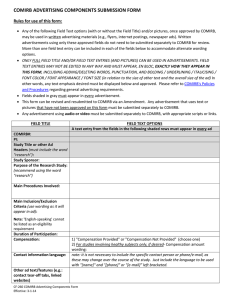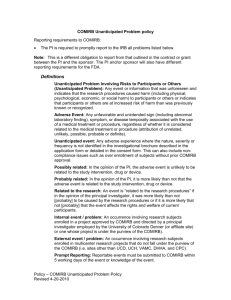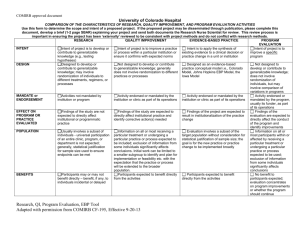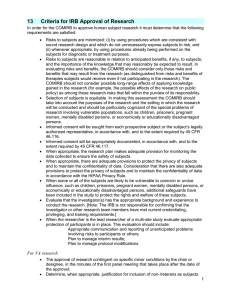Instructions – How to complete the COMIRB protocol template (Social)
advertisement
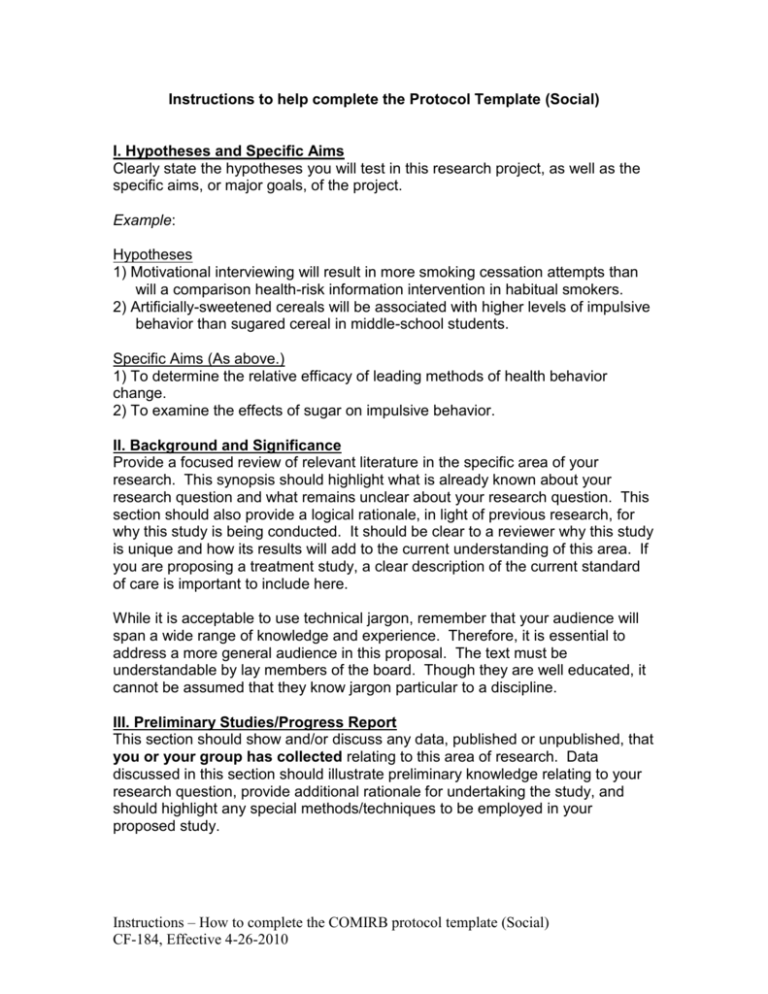
Instructions to help complete the Protocol Template (Social) I. Hypotheses and Specific Aims Clearly state the hypotheses you will test in this research project, as well as the specific aims, or major goals, of the project. Example: Hypotheses 1) Motivational interviewing will result in more smoking cessation attempts than will a comparison health-risk information intervention in habitual smokers. 2) Artificially-sweetened cereals will be associated with higher levels of impulsive behavior than sugared cereal in middle-school students. Specific Aims (As above.) 1) To determine the relative efficacy of leading methods of health behavior change. 2) To examine the effects of sugar on impulsive behavior. II. Background and Significance Provide a focused review of relevant literature in the specific area of your research. This synopsis should highlight what is already known about your research question and what remains unclear about your research question. This section should also provide a logical rationale, in light of previous research, for why this study is being conducted. It should be clear to a reviewer why this study is unique and how its results will add to the current understanding of this area. If you are proposing a treatment study, a clear description of the current standard of care is important to include here. While it is acceptable to use technical jargon, remember that your audience will span a wide range of knowledge and experience. Therefore, it is essential to address a more general audience in this proposal. The text must be understandable by lay members of the board. Though they are well educated, it cannot be assumed that they know jargon particular to a discipline. III. Preliminary Studies/Progress Report This section should show and/or discuss any data, published or unpublished, that you or your group has collected relating to this area of research. Data discussed in this section should illustrate preliminary knowledge relating to your research question, provide additional rationale for undertaking the study, and should highlight any special methods/techniques to be employed in your proposed study. Instructions – How to complete the COMIRB protocol template (Social) CF-184, Effective 4-26-2010 This section is important to demonstrate to the reviewers of your protocol that: a) you or your team has experience/expertise in this area of research and b) your team will be able to perform the measurements that are proposed in this protocol. IV. Research Methods A. Outcome Measure(s). List the primary and secondary (if applicable) outcome measures you will use in this study. Example: Outcome measures will be based on comparison of the survey data from participants during the month prior to the start of the group participation, and during the month following the conclusion of each group. B. Description of Population to be Enrolled. Describe the inclusion and exclusion criteria for your subject selection. [The inclusion and exclusion criteria must be the same as listed in the application form]. Discuss why this population has been chosen. C. Study Design and Research Methods. Provide a clear and complete description of the study timeline (that individual subjects would experience) and procedures used in each phase of the study. Such a description will generally include an overview of screening visit(s)/procedures; randomization procedures (if applicable); description of the experimental intervention(s) or treatment(s) study visits/procedures described temporally and sequentially; and follow-up visits/procedures. Procedures can be listed by name only in this section, as you will provide details about specific methods below (see D. Description, Risks, and Justification of Procedures and Data Collection Tools). Specify what tests are being done primarily for safety evaluation purposes. If you are proposing a treatment study, carefully specify what procedures are standard of care It is very helpful to provide a Figure and/or Table to illustrate the study design and timeline (a picture is worth a thousand words). If clear enough, these Figures/Tables can take the place of text descriptions in this section. Remember, this section must be able to provide a clear picture of what subjects will undergo to a reviewer who is not intimately familiar with your study. Not all study designs will fit this precise format and might require some adaptation. For example, if you are proposing a retrospective chart review: your screening procedures might detail how you will decide whether or not to include a specific case in your data analysis; study visits might describe what data you will collect when examining each chart; and follow-up might discuss how you will decide if/when to go back and review a chart again. D. Description, Risks, and Justification of Procedures and Data Collection Tools. Provide an itemized list of all specific procedures and methods for data collection that are listed in section C above. For each listed procedure, describe what the procedure entails, discuss the potential risks of the procedure, and state Instructions – How to complete the COMIRB protocol template (Social) CF-184, Effective 4-26-2010 why the procedure is necessary to achieve the study objectives. Specialized procedures that are unique to your type of research will likely require greater descriptive detail to make sure someone who is not intimately familiar with the procedure can evaluate its risks and benefits. E. Potential Scientific Problems. Briefly discuss the limitations to your proposed study design. Are there factors that could threaten your ability to obtain meaningful generalizable knowledge from this study? F. Data Analysis Plan. This section should include: For Quantitative analyses: 1. Describe the statistical test(s) that will be used to evaluate the primary and secondary outcome measure(s) (e.g., t-test, ANOVA, regression, etc.). 2. State which statistical test forms the basis for the sample size calculation. Justify the sample size, using the concepts of power, type I error and effect size where applicable, and note any assumptions that your power calculation is based upon. For Qualitative analyses: Describe the analyses you plan to use to generate the findings related to your research question(s) described above. Include detailed descriptions of analysis type (e.g. content analysis, ethnography, observational analysis, etc.) and justify use of these procedures over other qualitative analytic methods. G. Summarize Knowledge to be Gained. Describe the generalizable knowledge to you expect to be gained from performing this study. Discuss why this knowledge would advance your field of study. Instructions – How to complete the COMIRB protocol template (Social) CF-184, Effective 4-26-2010







